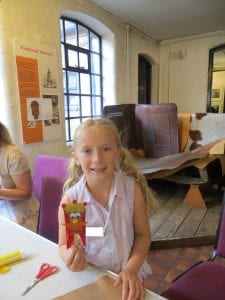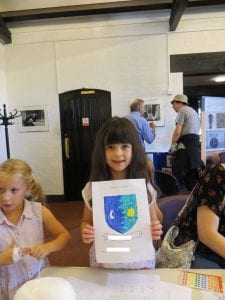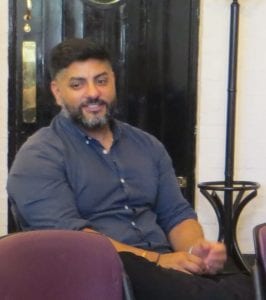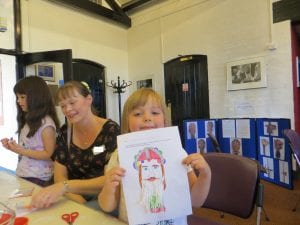Saturday 1st September 2018 saw Marianne Ailes and Bex Lyons from the project team in Walsall for an afternoon of Charlemagne-themed family activities at the Leather Museum.
 Walsall may seem a surprising place for an event celebrating Charlemagne, but the town boasts a rare, tangible reference to the medieval king. 17 wooden ceremonial clubs and staffs called ‘Bayard’s Colts’, now held at Walsall Leather Museum, include a ‘Charlemagne head’; a horse, thought to be Bayard, the mythical horse belonging to one of his barons (and from whom the clubs derive their name), and other figures. The clubs were probably carried during civic processions, dating back to the fifteenth century.
Walsall may seem a surprising place for an event celebrating Charlemagne, but the town boasts a rare, tangible reference to the medieval king. 17 wooden ceremonial clubs and staffs called ‘Bayard’s Colts’, now held at Walsall Leather Museum, include a ‘Charlemagne head’; a horse, thought to be Bayard, the mythical horse belonging to one of his barons (and from whom the clubs derive their name), and other figures. The clubs were probably carried during civic processions, dating back to the fifteenth century.
In a press statement for the event, Dr Ailes said: ‘Bayard first appeared in an early 13th-century epic French epic poem and was a wonder horse capable of carrying four men at a time and of understanding human speech.’
‘Belonging to the knight Renaud, one of Charlemagne’s rebellious barons, the horse is eventually captured by the emperor who ties a large stone to Bayard’s neck and has the horse pushed into the river. Bayard however smashes the stone with his hooves and escapes to live forever more in the woods.’
The afternoon featured Charlemagne-inspired art workshops, including clay modelling, felt and leather working, drawing, and other crafts. Storyteller Cath Edwards retold William Caxton’s version of The Four Sons of Aymon, but with the focus on Bayard the horse. Families also designed their own coat of arms, with the help of heraldry expert Adrian Ailes, visiting fellow at the University of Bristol.
Feedback from the event showed that everyone had a rewarding time. Of the children who filled in a feedback form all gave the event a smiling face for their overall experience, and the average rating was 4.9 stars out of 5.00. None of the adults who completed the form previously knew about the Charlemagne legend and Bayard the horse. 75.5% said they would definitely return to the leather Museum and 25% said it was likely that they would return. The interactive story-telling was rated especially highly by the children.
The Museum itself, housed in a former leather factory, provided a fascinating location and those who arrived early were able to explore Walsall’s tradition in leather-making.
The event was intended to stimulate local interest in these fascinating artefacts, which are now kept in storage. Two of the Colts were on display on the day, and provoked great interest from the adults who were there, most of whom were unaware of Walsall’s unique heritage. It aimed also to inspire other Charlemagne-related events and activities, and to provide meaningful outreach from the project.

Adults also enjoyed learning about Charlemagne at this family event.

It is hoped that the event will inspire other Charlemagne-related events and activities in Walsall and elsewhere.